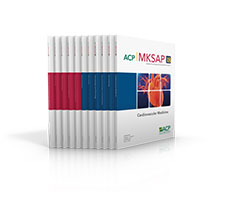 MKSAP has been trusted by internists since 1967 as the best resource for updating knowledge. MKSAP 18, available in Complete, Digital, and Print packages, consists of 11 comprehensive text chapters with related multiple-choice questions. You'll find 1,200 completely new questions to help you identify learning gaps, stay current, and gain the knowledge you need to provide the best possible patient care. MKSAP 18's original and high-quality questions evolve out of case studies and patient scenarios based on the latest evidence.
MKSAP has been trusted by internists since 1967 as the best resource for updating knowledge. MKSAP 18, available in Complete, Digital, and Print packages, consists of 11 comprehensive text chapters with related multiple-choice questions. You'll find 1,200 completely new questions to help you identify learning gaps, stay current, and gain the knowledge you need to provide the best possible patient care. MKSAP 18's original and high-quality questions evolve out of case studies and patient scenarios based on the latest evidence.
For more information on MKSAP 18, or to order your copy, visit mksap18.acponline.org.
MKSAP 18 Q & A
A 54-year-old man is evaluated for a 6-month history of right shoulder pain. He describes the pain as moderately severe aching that is diffusely localized over the shoulder without radiation to the arm. The pain is constant, although it is worse at night and with any shoulder movement. The pain was insidious in onset and has been progressively worsening. He has had no neurologic or constitutional symptoms. Ibuprofen provides some pain relief.
On physical examination, vital signs are normal. Pain and limited range of motion are noted with both active and passive movement in all planes of motion, as is diffuse tenderness over the anterior and posterior areas of the right shoulder. There is no tenderness to palpation of the bony or soft tissue structures, nor is there cervical spine tenderness. There are no neck symptoms or findings.
Which of the following is the most likely diagnosis?
A: Acromioclavicular joint degeneration
B: Adhesive capsulitis
C: Bicipital tendinitis
D: Rotator cuff disease
Back to the September 2019 issue of ACP International

